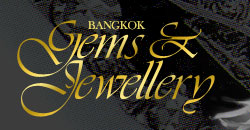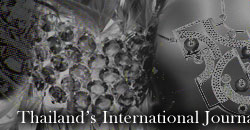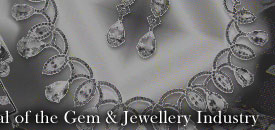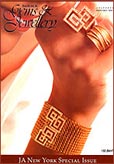 |
 |
 |
 |
Old
issues |
Vol.
18 No. 12 -- July 2005 |
||
 |
||||
| Chalcedony The Stone Age Gem | |
|
|
 |
|
|
|
 |
|
1
Hand-carved white chalcedony angel with a natural dendritic pattern
2 Lemon chrysoprase 3
Peruvian chalcedony 4 Green & aqua chalcedony 5 Green chalcedony 6 Yellow chalcedony 7 Lavender chalcedony |
|
As is clear by now, chalcedony is not one mineral but the name given to a whole family of minerals just like quartz, In fact, chalcedony is a kind of cryptocrystalline quartz, however unlike quartz, it is not clear and glassy to look at, rather it is translucent to opaque and has a waxy lustre. Like quartz though, chalcedony is primarily made up of silicon dioxide. Where the major difference lies though is in the physical make up of these two minerals. Quartz is divided into two types by mineralogists: crystalline and cryptocrystalline. Chalcedony is a form of cryptocrystalline quartz. The atoms in cryptocrystalline quartz pack together to form stones that are either opaque or translucent, The atoms take the form of fibres rather than crystals and there is often water or air trapped between the layers of fibres. These fibres sometimes run parallel to each other and sometimes they are entwined. Actually cryptocrystalline means that there are crystals but thatthey are so microscopically small that they cannot be seen without very high magnification. Its crystalline nature is only revealed in a thin section by transmitted polarised light seen under a microscope, Chalcedony also tends to be porous and can be dyed in different colours. |
|
 |
|
Chalcedony basically occurs as a secondary mineral in volcanic rocks, representing the silica setfree by the decomposition of the various silicates deposited in cracks, forming veins, or in vesicular hollows forming amygdales. It is found in all fifty states of the United States of America, in the basalts of North Ireland, the Faroe Islands, and Iceland. It is found in the Deccan region of India, and in the volcanic rocks of Brazil and Uruguay. Actually, since it is such an abundant mineral, itisfound most everywhere. Chalcedony in fact occurs in virtually all mineral environments and is therefore associated in some way with almost all types of minerals. The chalcedony family is informally divided into two main types: chalcedony, which is uniformly coloured, and agate, which is either banded or otherwise distinguished by zones of different colours. Agate is a very common variety of the chalcedony group of minerals. Like chalcedony itself, its name too is said to have a geographical origin, deriving from the Achates River that flowed through Sicily in ancient times, It is conspicuously colour banded with layers of other minerals within the body of the stone. Agates themselves come in so many varieties that they form a sub group of their own. |
|
 |
|
One of the prettiest forms of agate is moss agate, sometimes also referred to as mocha stone. It is greyish to milky white and is patterned with dark coloured dendritic branches that resemble moss, ferns or other vegetation in often pleasing designs. The dendritic branches are caused by the inclusion of manganese and iron oxide impurities. Fire agate is a brown type with a botryoidal (grape like) growth form. It has layers of plate-like crystals of iron oxide in various planes within its mass. The interference of light rays as they travel through these thin layers results in iridescent colours of red, gold, green and very rarely, blue-violet. The phenomenon is more or less the same as that which results in the rainbow colours on the surface of an oily puddle. Fire agates usually occur in pockets within colourless, white or light grey chalcedony and is only found on the North American continent. It is a difficult material to cut properly and is usually polished into cabochons. In order to reveal the colours, the overlying chalcedony must be removed from the botryoidal surface, creating a freeform shape that immediately renders it unusable for mass produced jewellery even though it is relatively inexpensive as compared to other gemstones. |
|
 |
|
A very interesting variety of agate is called thunder egg. Thundereggsareactually a kind of solid geode, a rocky shell with a filling of agate. They form in rhyolite lava beds where it is possible that the volcanic gases left bubbles in the rock that were later filled by mineral solutions that leaked into the cavity. Then there is onyx, which has black and white alternating bands. Onyx is used in cameos and intaglios to show off the colour contrast between the design and the background. Sardonyx is a sub variety of onyx with white and red layers. Bloodstone, which is also known as heliotrope, is a dark green variety of chalcedony with nodules of bright red jasper distributed throughout the body of the stone. The appearance of the bright red drops of blood as it were, made this stone especially important during the Middle Ages, when it was used mainly in sculptures representing flagellation and martyrdom. Legend says that bloodstone formed when drops of Christ's blood fell on some green jasper that lay at the foot of his cross. |
|
 |
|
Cornelian is an all red, translucentvariety that gets its colour from the presence of iron oxide in the stone. It is closely related to sard, which is brown in colour. Chrysocolla is a beautiful robin's egg blue colour and sometimes looks like fine quality turquoise. Its colour ranges from blue green to green and derives from the presence of copper. Unfortunately, pure chrysocolla is too soft to be used in jewellery by itself, but when it forms in conjunction with quartz, it can be utilised as a gemstone. Chrysoprase is a beautiful yellow-green to bright apple green variety of chalcedony. The bright green variety tends to look like the finest quality jadeite, It owes its colour to the inclusion of nickel silicates but the colour is not entirely stable and can be lost with prolonged exposure to sunlight or by the application of heat. Nevertheless, chrysoprase is considered to be among the most valuable varieties of chalcedony. Another green variety of this gem group is plasma. Plasma occurs in many different shades of green, which are caused by amphibole or chlorite inclusions. Plasma is often found with nodules of grey quartz or bloodstone in its mass, It is mainly used for carvings and mosaics. |
|
 |
|
Aventurine is another form of chalcedony that is extensively used in carvings, though these are mainly in the form of bowls, vases and ornaments. Aventurine comes in many colours, however its most common form is green and it has often been mistaken forjade. Most aventurine tends to sparkle due to tiny bits of other matter embedded in it. This phenomenon is called aventurescence. The colour of the glitter depends on the nature of the inclusions. Mica will give a gold or silver glitter, hematite (iron oxide) and goethite will make it gleam with red or green spots and the presence of fushite will result in a glistening green look. |
|
 |
|
Blue chalcedony is generally what the consumertendsto think of in association with the term chalcedony. There are many different shades of blue from the palest and lightest to deeper hues. Some pieces display a slight adularescence, which enhances their appearance and consequently their value as well, Good quality blue and purple chalcedony is being mined in Turkey and several locations in Africa as well as Indonesia and the United States. In fact, Indonesia also produces good quality yellow to deep orange coloured goods. Chalcedony also tends to pseudomorph after organic materials. A common example is petrified wood, i.e. wood that has been completely transformed into chalcedony by displacement of its organic material. The Petrified Forest National Park in Arizona, USA, is an entire forest of trees that were transformed into petrified wood and the remains of this forest can be seen in the huge silicated logs that are found in the area. |
|
 |
|
Another variety of pseudomorph is petrified coral, which is found in the Tampa Bay area of Florida. Most of the coral in the bay has been replaced by chalcedony and the mineral while replacing the organic material has preserved its original form, There are also chalcedony pseudomorphs of petrified dinosaur bone. One of the most interesting chalcedony pseudomorphs is the tiger's eye. This gem has a very interesting and confusing appearance, It is caused by the transformation of the finely fibrous structure of crocidolite into chalcedony through the process of pseudomorphism. |
|
 |
|
All in all, while chalcedony is not an expensive gem, being so abundantlyfound in virtually every mineral rich locality, it is certainly one of the most interesting mineral groups and is a definite favourite with amateur collectors who can make up a fascinating collection at a relatively low price. The most amazing fact about it is its long lived popularity that has seen this mineral family in constant use for ornamentation from the earliest prehistorical stages of human evolution to modern times. |
|
 |
|
| 1 Florentine
mosaic is just another term for the commesso art form. It is mainly used
in making pictures or decorating furniture and small
wall panels. 2 ,3 Commesso is a form of art that uses thin silvers of semi precious gems cut to shape to make beautiful picures like these shown above 4 Snuff bottles carved from blue chalcedony |
|
|
C
o p y r i g h t © 2 0 0 0 - 2 0 1 6 D4U
WEB TM A l l R
i g h t s R e s e r v e d |
|